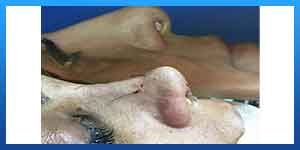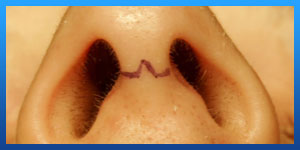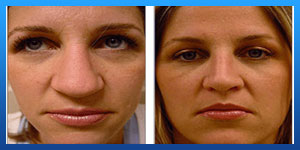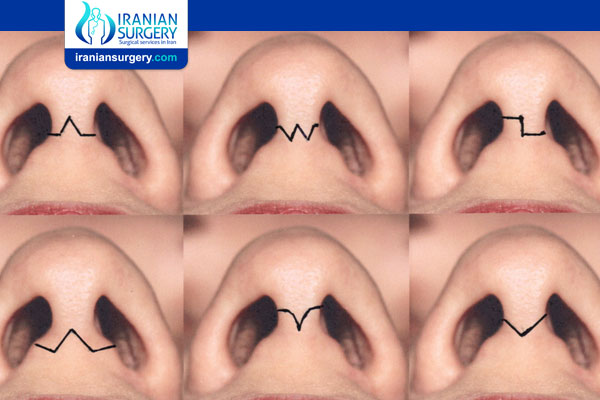Rhinoplasty Scar
Scarring after Rhinoplasty
Does Rhinoplasty Leave Scarring?
Rhinoplasty surgery can change the shape, size, and structure of the nose, delivering incredible results for the right patient. But just like any other surgery, there is one major drawback if not handled well: the potential for developing noticeable scar tissue after your healing is complete. Even rhinoplasty surgery with its well-hidden incisions can create visible scar tissue. To keep your results looking more natural without such scarring, you’ll need to take some necessary precautions.
Read more about : How to hide blepharoplasty scars?

Read more about : Rhinoplasty surgery before and after
Read more about : Rhinoplasty podcast with Dr Afshan shah
Read more about : When can i touch my nose after rhinoplasty?
Read more about : How long should i tape my nose after rhinoplasty?
Why does Scar Tissue form?
There is no such thing as a surgery without some scar tissue. When an incision is made in the skin, the body naturally creates scar tissue to heal the wounds. Scars are formed by dense, fibrous connective tissue that can seal the wound closed. Think of it as your body naturally forming a Band-Aid to heal a wound. It is nothing to be alarmed about, really. Once it is formed, scar tissue can sometimes be remodeled or reshaped with the help of a facial plastic surgeon or another highly trained specialist. For a rare few, the body may also produce too much scar tissue and cause problems with healing.
Read more about : Bad smell in nose after rhinoplasty
Read more about : When can i sleep on my side after rhinoplasty?
Read more about : Nose job simulator
Read more about : Revision rhinoplasty
Read more about : Sex after rhinoplasty
Read more about : Rhinoplasty in Iran
Where will Scar Tissue form after Rhinoplasty?
Rhinoplasty surgery can be performed in two different ways:
. Open Approach – It involves one small, well-concealed incision between the nostrils on the underside of the nose. This technique allows the greatest access to the nasal tip as well as the lower and middle third of the nose.

. Closed Approach – Also called endonasal rhinoplasty, this technique uses incisions that are exclusively made within the inside of your nostrils. This method will not leave behind any visible skin incisions.
Read more about : Open rhinoplasty
Read more about : Closed rhinoplasty
When scar tissue forms, it will start at the location of these incisions but can become noticeable if care isn’t taken to prevent it. Patients who do experience the formation of excess scar tissue after rhinoplasty will likely develop it around the nasal tip region. Because this area may appear swollen for a time after surgery, you should raise any concerns you have about potential scarring with your facial plastic surgeon.
What causes Scars to get worse?
Several factors can make your rhinoplasty scar get worse:
. Infection – If the incision site gets infected, your wound healing is interrupted. In some cases, the cut grows as the skin pulls away from this area. Your body’s energy moves away from healing the cut to trying to fight off the bacteria.
. Sun Exposure – UV rays darken scar tissue and make it more noticeable than it would otherwise be. The pigmentation acts as a frame for the incision site and contrasts with the skin around it.
. Smoking – If you smoke, your blood has a lower oxygen concentration than a non-smoker. The body needs this oxygen supply to fuel the healing process, so smokers typically encounter slower rates with a higher risk of developing scars.
. Damaged Skin – Your skin’s condition plays a part in whether you have clean healing or a lot of scar tissue. Dry and cracked skin makes it difficult for the body to heal your septum properly from the incision, while well-moisturized skin has less of a problem in this area.
. Age – Your body’s natural healing capabilities decrease as you get older, although everyone has their own pace for this process. You can’t heal a scar as well at 60 as you can at 20, so keep your age in mind when determining whether you’re going to end up with a visible scar.
. Allergic Reaction – Allergies to anything used at the incision site or the postoperative supplies can cause irritation, rash or infection in the wound. If you don’t address this matter quickly, you could end up with a much larger scar.

Read more about : Revision Rhinoplasty in Iran
Read more about : Sign of infection after Rhinoplasty
Read more about : Rhinoplasty cost in iran vs other countries
Read more about : Rhinoplasty cost in Iran
What does the surgeon do to minimize Scarring?
In a traditional open (or external) rhinoplasty, surgeons are meticulous when making the incisions to reduce the chance of unnecessary scarring. The technique is referred to as a columellar incision (or a V-Plasty incision) and resembles an open triangle, ‘V’ or a staircase. During the procedure, the surgeon is careful to not cause any extra irritation that will affect the healing process. Plastic surgeons (or any surgeons working with incisions) say that closing the incision is the most vital part of ensuring minimal scarring.
How can you Minimize Rhinoplasty Scars?
While scar tissue may be common after any surgery, there are things patients can do to reduce its occurrence:
. Avoid smoking and drinking – Nicotine constricts the blood vessels and contributes to poor healing and scarring. Alcohol, on the other hand, not only causes skin dehydration but can also promote swelling and bleeding.
. Don’t strain yourself – Any activity that causes your blood pressure to rise may increase your risk of scar tissue formation.
. Clean the Incision Site – Your plastic surgeon will give you full instructions on how to clean the incision site after you go home from the procedure. You need to follow these exactly to keep the area clear of bacteria, debris and anything else that could irritate the wound or stop it from healing.
. Avoid Strenuous Activity for a Week – You don’t want to strain your nose or disturb the cast that’s in place as it heals. A few things you should avoid include blowing your nose, picking up heavy weights or doing anything that could result in nose trauma.
. Stay Out of the Sun – The scar tissue may not fully fade for up to a year, depending on how your body handles scarring. During this time, sun exposure can cause the mark to darken. Use sunscreen in this area so you limit any damage.
. Control Swelling –Your nose swells as part of the healing process after your surgery. Use ice packs and other methods to control the swelling so you don’t risk the incision pulling apart or damaging the healing process. Plus, you will feel more comfortable when you have a handle on this part of the rhinoplasty process.
. Follow all recovery instructions – Guidelines are provided to help you heal faster. By taking these instructions seriously, you get to avoid complications and quickly achieve your desired results.
. Choose the right plastic surgeon – One of the best ways to prevent complications like scarring is choosing a surgeon who is board-certified, highly qualified, and experienced in the rhinoplasty procedure.
. Watch for Infections – Your incision site will look red immediately following your rhinoplasty, and some blood and drainage will occur. If the redness gets worse or you see pus, blood and other fluids coming out of the wound following this period, talk to your plastic surgeon. Another sign of infection is hot to the touch skin, or if you start running a fever without any mitigating circumstances. Infections cause major damage and may even be life-threatening, so get help right away.
You don’t have to worry about rhinoplasty scars in most cases, as much of the work is done inside the nostrils rather than on the outside of the nose. The appearance of rhinoplasty scars is discouraging. Having a plastic surgeon with proper training and plenty of experience will ensure that the worry of a scar will not overpower the excitement of your new nose. By closely following your scar management plan, any surgical scars will likely be gone in 3-6 months.
Read more about : How to get rid of scar tissue after rhinoplasty?
Read more about : Revision rhinoplasty success rate
Read more about : Iranian nose job pictures
Read more about : Rhinoplasty types and techniques
Read more about : Non surgical rhinoplasty
Read more about : is rhinoplasty permanent?
Read more about : How long after breast reduction will i know my size?
Read more about : Hives after bariatric surgery
Read more about : How to fix a deviated septum without surgery?
How can Scar Tissue be treated?
If you experience problems with the formation of excess scar tissue following your rhinoplasty surgery, there are things you can do to reduce it, as well as medical procedures that will help you achieve more natural-looking results. Options include:
. Steroids – A series of carefully targeted cortisone steroid injections can help minimize the appearance and extensiveness of the scar tissue.
. Revision rhinoplasty – Corrective surgery can be performed to remove the scar tissue without impacting any other structures of the nose.
Adjustments can be made in both surgical and nonsurgical techniques, so start the conversation with your facial plastic surgeon today and take it from there.
Read more about : Sign of infection after rhinoplasty
Read more about : Revision Rhinoplasty
Read more about : Best age for rhinoplasty


